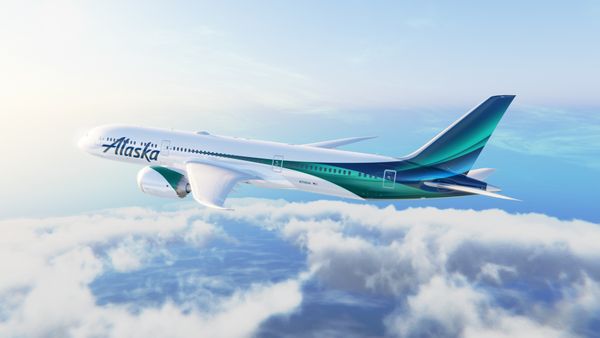ZIPAIR Tokyo, established in 2018 as a subsidiary of Japan Airlines (JAL), operates as a low-cost carrier (LCC) specializing in long-haul international routes. The airline's business model focuses on providing affordable air travel by implementing cost-saving measures and offering optional services for additional fees.
A Lean, No-Frills Business Model
As an LCC, ZIPAIR minimizes operational costs by utilizing a simplified service model. The airline operates a fleet of eight Boeing 787-8 Dreamliners, which it leases from parent company Japan Airlines. The aircraft are known for their fuel efficiency and are designed for long-haul routes, reducing operational costs per passenger mile compared to older, less efficient planes.

Moreover, ZipAir maximizes revenue with a high-density cabin layout. Each Boeing 787-8 in its fleet is configured with 290 seats, including 18 lie-flat "Zip Full-Flat" seats in a premium cabin (1-2-1 layout) and 272 standard economy seats (3-3-3 layout). It also offers free internet connectivity to all passengers via the aircraft’s satellite link. This helps the airline reduce costs by forgoing traditional in-flight entertainment systems and complimentary services, instead offering free Wi-Fi and encouraging passengers to use their own devices for entertainment.
To maintain low base fares, ZIPAIR offers optional add-ons such as in-flight meals, seat selection, and checked baggage. This allows passengers to customize their travel experience based on their preferences and budget. This unbundled pricing strategy enables travelers to pay only for the services they require, contributing to the airline's affordability. For example, a checked bag up to 50 pounds on a U.S.-Tokyo route costs $59, while a hot meal might set you back $15–20—still far cheaper than the bundled amenities of full-service airlines.

ZipAir’s route network is carefully curated to balance demand with cost efficiency. It focuses on high-traffic leisure and business corridors, like Tokyo to Honolulu, Los Angeles, San Francisco — and the newly-launched Houston on March 4, 2025 — where it can compete with legacy carriers on price. To drum up early interest for the new route, ZIPAIR offered promotional fares from Houston to Tokyo starting at $333 one-way, compared to the regular fare to be offered on the route, which is expected to be around $450 each way.
The new service between NRT and IAH is ZIPAIR’s fifth trans-pacific destination after Los Angeles, San Francisco, San Jose, and Vancouver. The airline also serves Honolulu in Hawaii, as well as several Asian cities. Off-peak flights can drop as low as $91 for kids under six or $325 for adults, making it a lifeline for budget-conscious families and solo travelers during a time when legacy carrier fares often soar past $1,000 round-trip.
In addition, the airline has achieved a 7/7 safety rating from AirlineRatings.com, indicating compliance with international safety standards and a strong safety record.

In terms of customer experiences with ZIPAIR, there are mixed feelings from passengers reflecting the airline's low-cost model. Flights are point-to-point, with no codeshares or interline agreements, so connections depend on passengers' independent planning. Customer service can be sparse, and flexibility is limited: changes within seven days of departure forfeit most of their fare. Yet, for those who pack light, plan ahead, and prioritize price over pampering, the savings are hard to beat.
Alaska Airlines Launching 787 Service to London, Rome » Greenland Airport Security Team Skips Work to Go Hunting, Delays Flights by 3+ Hours » Why Zipair Tokyo is so Cheap: A Look into Japan's Long-Haul Low-Cost Airline »
Comments (0)
Add Your Comment
SHARE
TAGS
INFORMATIONAL Zipair TokyoLong-HaulLow-costAirlinesB787JapanTravelRECENTLY PUBLISHED
 Why Zipair Tokyo is so Cheap: A Look into Japan's Long-Haul Low-Cost Airline
ZIPAIR Tokyo, established in 2018 as a subsidiary of Japan Airlines (JAL), operates as a low-cost carrier (LCC) specializing in long-haul international routes. The airline's business model focuses on providing affordable air travel by implementing cost-saving measures and offering optional services for additional fees.
INFORMATIONAL
READ MORE »
Why Zipair Tokyo is so Cheap: A Look into Japan's Long-Haul Low-Cost Airline
ZIPAIR Tokyo, established in 2018 as a subsidiary of Japan Airlines (JAL), operates as a low-cost carrier (LCC) specializing in long-haul international routes. The airline's business model focuses on providing affordable air travel by implementing cost-saving measures and offering optional services for additional fees.
INFORMATIONAL
READ MORE »
 Greenland Airport Security Team Skips Work to Go Hunting, Delays Flights by 3+ Hours
Nuuk Airport (GOH) descended into an unusual form of travel chaos on Aug 03, 2025, when United Airlines flight UA81 to Newark was delayed for hours, not due to weather, mechanical issues, or labor strikes, but because the airport’s security staff simply did not show up for work.
NEWS
READ MORE »
Greenland Airport Security Team Skips Work to Go Hunting, Delays Flights by 3+ Hours
Nuuk Airport (GOH) descended into an unusual form of travel chaos on Aug 03, 2025, when United Airlines flight UA81 to Newark was delayed for hours, not due to weather, mechanical issues, or labor strikes, but because the airport’s security staff simply did not show up for work.
NEWS
READ MORE »
 Alaska Airlines Launching 787 Service to London, Rome
Alaska Airlines is sharpening its aspirations to become a more premium long-haul airline. The carrier announced two new transatlantic routes launching in the Spring of 2026 alongside a new brand identity that will be sported by its growing fleet of Boeing 787s.
NEWS
READ MORE »
Alaska Airlines Launching 787 Service to London, Rome
Alaska Airlines is sharpening its aspirations to become a more premium long-haul airline. The carrier announced two new transatlantic routes launching in the Spring of 2026 alongside a new brand identity that will be sported by its growing fleet of Boeing 787s.
NEWS
READ MORE »


